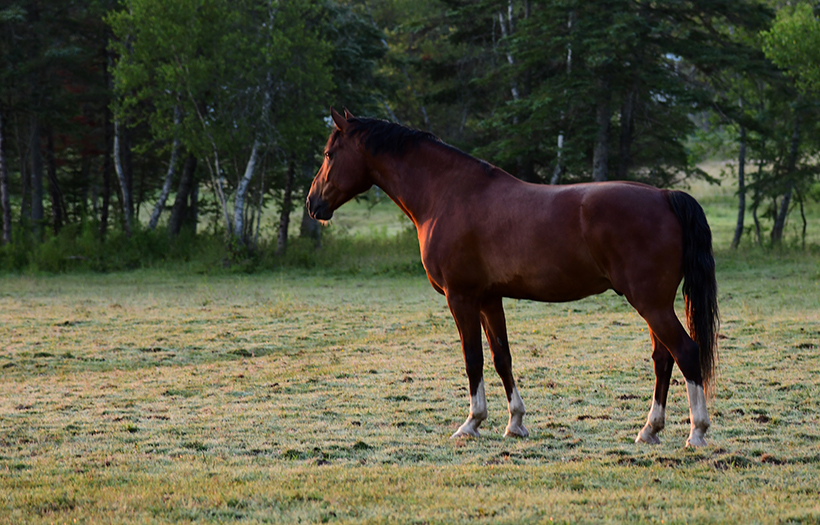Topline is Key to Horse Well-Being

A poor topline is commonly viewed as a result of lack of exercise, inadequate saddle fit or genetics. However, nutrition is also an essential, and often overlooked, element to consider when looking for a solution to improve a horse’s topline and overall muscling.
WHAT IS THE TOPLINE?
The topline is the group of muscles in the horse’s back running from the withers to the croup. These are vital muscles that affect performance and may cause lameness.
To evaluate topline muscling, a scale ranging from A (full muscling over the entire length of the back) to D (no topline muscling) can be used. Three areas are assessed: the withers, the back and the croup. Each area is worth a point. With 3 points, the horse scores an A; with 2 points, a B; with 1 point, a C. Three negative points result in a D. It is interesting to know that while a horse will gain fat from front to back, muscle mass increases from the back to the front. In other words, a horse will build muscle from the hindquarters to the withers.
Based on a survey of
American Association of
Equine Practitioners
(AAEP), 70% of equine
veterinarians consider
that adequate muscling
surrounding the horse’s
spine is key to equine
well-being.
BODY CONDITION SCORE, MUSCLE MASS AND DIET
Body condition and muscle mass should not be confused. A horse with poor muscling might still have a good body condition score (BCS). However, if a horse is too thin, it will have a harder time gaining muscle mass. At the other end of the spectrum, a horse that is too fat may appear to have a good topline, but if it has a BCS of 7 or more on a scale of 9, the topline could be simply covered by fat, which is, quite frankly, much less useful to a working horse!
How can nutrition help muscle development? By providing the necessary building blocks! Indeed, exercise alone is not enough to build muscle mass. Exercise will stimulate the growth existing muscle fibres, but it cannot form new ones. Protein, and most importantly, quality amino acids are needed to build new muscle. A working horse which lacks sufficient quality protein may even lose muscle mass, not to mention suffer from other possible consequences, including a lack of appetite, weak hooves, a dull coat, etc.
WHAT IS QUALITY PROTEIN?
Proteins are chains of amino acids. Some of these amino acids are produced by the horse’s metabolism. Others, known as limiting amino acids, must come from the horse’s diet. Limiting amino acids are essential for normal body function and for the maintenance and development of muscle mass. To be adequately absorbed by the body and to play their role, amino acids must be combined in the correct proportions. Let’s take the alphabet to illustrate this. If you have many consonants but no vowels, you will not be able to form a word. The same goes for limiting amino acids; if you do not have them all, not all functions can be fulfilled.
Limiting amino acids are found in the horse’s diet when it is fed quality ingredients. Such ingredients include soybean meal that is high in lysine and corn gluten that contains methionine. Hay does contain protein, but few limiting amino acids and grain contains very little protein. Amino acids in pure form may be added to feeds to increase the amount provided in the diet. To know if your feed contains limiting amino acids, you will need to ask for an ingredient list because the guaranteed analysis on the label reveals very little information. As a matter of fact, the calculated crude protein gives no information on the source or the quality of the protein. Mills base their assessment on the level of nitrogen in the feed to calculate the levels of crude protein. Since most proteins contain 16% nitrogen, the total nitrogen content in the product is divided by 0.16 (e.g. a food containing 1.6% nitrogen would have a crude protein content of 10%). This calculation method is dictated by the regulatory bodies.
The way the feed is processed must also be considered to make sure a feed not only contains enough limiting amino acids, but is also highly digestible. For example, if it was cubed at too high a temperature, a feed will become less digestible, and the protein will be less available. The same phenomenon occurs when hay has heated up.
The best time to serve protein is 45 minutes after exercise: this is when nutrient absorption is at its maximum, and the horse’s recovery will be optimal. Serving protein before exercise will have very little impact as limited protein absorption or muscle production occurs during exercise. A horse should therefore be fed a high-quality protein meal as soon as it has resumed its normal heart and respiratory rate.
BEWARE OF MYTHS
It is a common misconception that some breeds or lines are less likely to develop a large muscle mass. Horses of all breeds can build muscle but there will be variations in the type and composition of muscle fibres they will develop.
Be cautious of so-called miracle products said to promote muscle development. Creatine, for example, has no effect on the muscle development of horses since it is not plant-sourced and therefore it is very poorly assimilated. Another product that is sometimes used is gamma oryzanol. Studies have shown that it is not effective at increasing muscle mass, but that it may help reduce muscle damage during exercise.
IN CONCLUSION
For a strong topline and well-toned muscle, exercise and a good saddle fit count, but do not underestimate the importance of amino acids, the essential building blocks of muscle tissue!
